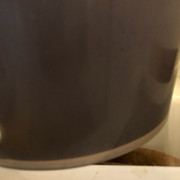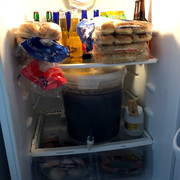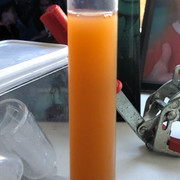Nubiwan
Well-Known Member
- Joined
- Dec 1, 2018
- Messages
- 584
- Reaction score
- 365
I have probably done a few iffy contamination things here, but it was a risk I am willing to accept. Wanted to share for comments, and might have a question at the end.
I bottled off an IPA a couple of days ago, which I had dry hopped about 5 days with just a half ounce of Centennial for a little flavour bite. My next batch is a Red Ale.
I am just doing extracts here, so I had my Red Ale all ready to go. My 1.8 KG Red Ale malt extract warming in sink to loosen her up, a KG of medium dry malt extract (MDME?) and a litte extra glucose syrop. Had the syrop and DME all mixed in a pot and ready while I bottled my IPA.
My IPA was siphoned into a clean bottling pale, yada yada. Once done, I quickly rinsed the bottling pale and used it as the primary for my next read Ale. Added all my fermenatables, and cold water, and took my OG before pitching.
Here is the iffy potential contamination bit. I emptied most of the excess liquid from my IPA primary via the spigot on the pale, into the sink. I then scooped some of the trub from the bottom and pitched it into the new batch. I used a sanitized, flat spatula to do this. It was taking forever. I threw caution to the wind, and simply poured a fair bitt of the trub out of the pale directly into my red ale. My main concern us that I might have transported some of the scud from the old Krausen into the new batch. Therefore contaminant. Should I be concerned, and how might this manifest in taste/odor/clinical rejection on my new batch?
As a side note, I did much the same with a recent cider batch, which was made by simply pouring 5 gallons of Apple juice over the trub from the previous ale batch I made. The results from that test - so far - have been decent, but I am not really that familiar with ciders to know good from bad, and still rather acquiring the taste. Plus, its only been bottled 2-3 weeks, so still young. But there is no foulness to the taste at all. The scud from the beer krausen was still atop my cider while it fermented. I added enough apple juice to come below the "scud mark"
Anyway, I pitched my trub / yeast at around 2PM Friday, and ferment started around midnight in earnest. By the time the Raptors had knocked the Bucks out of the playoffs, she was steadily fermenting. Sunday, she was charging along in my blowoff with bubbles every 5 seconds, and my gravity has dropped about 20 points already in about 48 hours. Nice 2 inch krausen atop my primary. Looks, and sounds, healthy.
I tried this rather as an experiment to see how fast I can get the beer to fully ferment. I read a post about getting beer to bottle in 7-14 days, so I am seeing how fast this bulk yeast attack with get me FG to level out. MY SG was 1.054, and I am at 1.034 earlier today. Any ideas what my FG should likely be? Will it go down to 1.010 range? Should I expect it to bottem out pretty quick? DOes the vlume of yeast determine attenuation you might acheive? Guess I could search that
Any comments on process of just dumping my trub out of the pale straight into the new primary? I imagine a few people might be cringing at reading how I did that. I realize I also have the remnant of the cenennial hops to xconsider in the trub, but I am hoping that will just add a little zing to my ale. Was only an ounce. Perhaps this was another big No No.... but again, its an experiment, and I will report my results later in this thread.

I bottled off an IPA a couple of days ago, which I had dry hopped about 5 days with just a half ounce of Centennial for a little flavour bite. My next batch is a Red Ale.
I am just doing extracts here, so I had my Red Ale all ready to go. My 1.8 KG Red Ale malt extract warming in sink to loosen her up, a KG of medium dry malt extract (MDME?) and a litte extra glucose syrop. Had the syrop and DME all mixed in a pot and ready while I bottled my IPA.
My IPA was siphoned into a clean bottling pale, yada yada. Once done, I quickly rinsed the bottling pale and used it as the primary for my next read Ale. Added all my fermenatables, and cold water, and took my OG before pitching.
Here is the iffy potential contamination bit. I emptied most of the excess liquid from my IPA primary via the spigot on the pale, into the sink. I then scooped some of the trub from the bottom and pitched it into the new batch. I used a sanitized, flat spatula to do this. It was taking forever. I threw caution to the wind, and simply poured a fair bitt of the trub out of the pale directly into my red ale. My main concern us that I might have transported some of the scud from the old Krausen into the new batch. Therefore contaminant. Should I be concerned, and how might this manifest in taste/odor/clinical rejection on my new batch?
As a side note, I did much the same with a recent cider batch, which was made by simply pouring 5 gallons of Apple juice over the trub from the previous ale batch I made. The results from that test - so far - have been decent, but I am not really that familiar with ciders to know good from bad, and still rather acquiring the taste. Plus, its only been bottled 2-3 weeks, so still young. But there is no foulness to the taste at all. The scud from the beer krausen was still atop my cider while it fermented. I added enough apple juice to come below the "scud mark"
Anyway, I pitched my trub / yeast at around 2PM Friday, and ferment started around midnight in earnest. By the time the Raptors had knocked the Bucks out of the playoffs, she was steadily fermenting. Sunday, she was charging along in my blowoff with bubbles every 5 seconds, and my gravity has dropped about 20 points already in about 48 hours. Nice 2 inch krausen atop my primary. Looks, and sounds, healthy.
I tried this rather as an experiment to see how fast I can get the beer to fully ferment. I read a post about getting beer to bottle in 7-14 days, so I am seeing how fast this bulk yeast attack with get me FG to level out. MY SG was 1.054, and I am at 1.034 earlier today. Any ideas what my FG should likely be? Will it go down to 1.010 range? Should I expect it to bottem out pretty quick? DOes the vlume of yeast determine attenuation you might acheive? Guess I could search that
Any comments on process of just dumping my trub out of the pale straight into the new primary? I imagine a few people might be cringing at reading how I did that. I realize I also have the remnant of the cenennial hops to xconsider in the trub, but I am hoping that will just add a little zing to my ale. Was only an ounce. Perhaps this was another big No No.... but again, its an experiment, and I will report my results later in this thread.

Last edited:









![Craft A Brew - Safale S-04 Dry Yeast - Fermentis - English Ale Dry Yeast - For English and American Ales and Hard Apple Ciders - Ingredients for Home Brewing - Beer Making Supplies - [1 Pack]](https://m.media-amazon.com/images/I/41fVGNh6JfL._SL500_.jpg)



















































